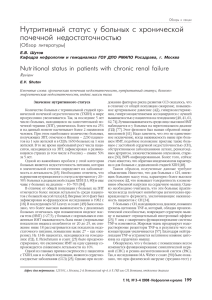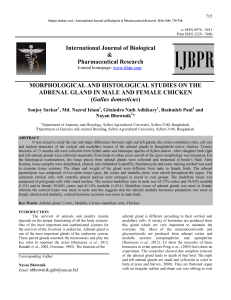L5 - Radiation diagnostics of diseases and injuries of the genitourinary system
advertisement

Radiation diagnostics of diseases and injuries of the genitourinary system (1 hour). 2. Genitourinary system - this term is combines different systems and very common. The term is not quite right. This system is better considered separately Urinary system - male or female minor differences, all the differences are the length of the urethra, otherwise the same - Male reproductive system - Female reproductive system And if we talk about radiodiagnostics the most time we need to spend on just urinary Cause reproductive system is a subject to study by ultrasound most of all. 3. Urinary system is kidneys ureters bladder urethra 4. When should I request a GU study? Urolithiasis disease, infection, trauma, neoplasia, and vascular diseases are the most common disoder affecting the genitourinary system. Hematuria is a symptom that must be considered a sign of possible cancer anywhere from the kidney to the bladder. Common reasons to request a genitourinary imaging study: Kidney, ureter, or bladder calculus Hematuria of unknown origin Flank pain Recurrent urinary tract infection Suspected renal, ureteral, or bladder cancer Scrotal mass Suspected testicular torsion - hemorrhage from the vagina or uterus - Low abdomen pain About ultrasound we will talk later, the first metod of radiodiagnostics is usual xray. 6. KIDNEY. The kidney is a paired organ. The kidneys are located in the lumbar region, in the retroperitoneal space on either side of the spine. Kidney size: length up to 10-12 cm, width 5–6 cm, thickness about 4 cm. The left kidney is longer than the right and is equal to 2 cm higher 7. Kidney overview radiograph The image covers the entire abdominal cavity from the level of the xiphoid process to the pubic bone. The kidneys are visualised as two bean-shaped shadows located at the Th12-L2 level. 12 rib crosses the upper pole of the kidney. in the small pelvis Generally this is AP abdomen x-ray Evaluate position, shape, contours of kidneys. May be visible shadows of calculus in the kidney, ureter, bladder 10. An intravenous urogram, is an examination performed by the intravenous administration of iodinated contrast. Contrast is filtered by the kidneys, allowing for assessment of renal function, filling of the renal collecting systems, the ureters, and the urinary bladder. Multiple films are obtained to demonstrate the sequential functioning of these structures. An IVP is one of the few X-ray tests that allow us to determine the function of an organ. Most other imaging studies are simply static images that provide anatomic detail. Indications IVU: abnormalities identified by ultrasound Arterial hypertension. Suspected kidney tumor, hematuria organs. 11. the patient must prepare: diet without fiber and meat (3 days) colon cleanse the evening before the study A series of X-ray films taken at 7, 14, 21 minutes in horizontaly (AP) + orthostatiс x-ray (in vetrically). the methodology in different clinics may differ 12. The kidney on the urograms is represented by an oval shadow. calyces and renal pelvis system was contrasted. calyces and pelvis varied. But symmetrical. which forms an obtuse angle with the pelvis axis. A renal mass will occasionally be visible on the abdominal plain film. When the plain film or the IVP is evaluated, the renal margins should be closely scrutinized. Kidney cancer most often presents with an abnormal contour bulge. 14. The ureter is a shadow in the form of a narrow strip, consisting of several patter ns, located almost parallel spine. The bladder is an oval-shaped shadow, lower contour at the level of the pubic bones. The shadow should be uniform structure, its smooth contours. 15. radionuclide scanning / scintigraphy Renal scintigraphy is a powerful imaging method that provides both functional and anatomic information The radionuclide should accumulate evenly. If there is dysfunction or canser, “cold focus”. 16. Left kidniy failure 17. Recently, CT has supplanted urogram in many imaging centers because it is quick, accurate, and allows for more detailed assessment of renal anatomy. Cysts and tumors are more accurately evaluated with CT. CT Indications Any unclear change on ultrasound or X-ray Congenital kidney disoder retroperitoneal space. 18. Study is carried out in horizontal position on the back. Series of images in axial projections consistently highlight various layers of the kidneys. Normal kidney is oval shaped with smooth and clear contours On the medial surface, visible renal sinus, differentiated arteries and veins. Density of the kidney parenchyma from +30 to +40 H. contrast enhancement is mainly used when a tumor is suspected 19. It is important to confirm that a renal cystic lesion is simple. A simple cyst is always benign, but some cystic lesions are malignant. A simple cyst on CT 1. Has no visible wall. 2. Has CT density measurements of 0. 3. Has no septa, mural nodules, or internal debris. 4. Is sharply circumscribed and round or oval in shape. 20. With CT, renal malignancy presents as a soft tissue mass that is solid and often lobulated. The lesion may be identical in density to the normal renal parenchyma on the noncontrasted images. With contrast, the kidney tumor becomes visible, often displaying areas of nonuniform enhancement. Renal neoplasms are extremely vascular. Rapid growth may outstrip the blood supply, resulting in central areas of low density, indicating tumor necrosis within the mass. The contour of the kidney is usually distorted and the collecting system is compressed and/or displaced. 23. How can I locate the adrenal glands on CT and what are the common pathologies? This is not GU system BUT this glands is located so that we can see it when study kidneys. The adrenal glands are located just superior and medial to the kidneys, usually on the 2—3 slices above the tops of the kidneys. These small structures can be hard to find in thin patients who do not have much intrabdominal fat. The adrenal glands are composed of two or three thin limbs that intersect at a small circular hilum. They most often have the shape of the letter Y or V. Adrenal adenomas are the most common adrenal pathology seen on CT. Adenomas are round or oval masses that are of slightly lower density than the normal adrenal tissue because approximately 70% of them are composed of a partial lipoid matrix. Adrenal hyperplasia is also fairly common, presenting with diffuse thickening of the adrenal limbs. Primary adrenal carcinoma is relatively rare. These masses are usually larger than 2 cm and may have a necrotic center. More common is adrenal metastasis. In fact, adrenal metastasis in lung cancer is common enough that we always include the adrenal glands on all chest CT scans. 25. MRI one of the most important advantage is the absence of ionizing radiation Indications Evaluation of the anatomical structure and structure of tissues kidneys; the boundaries of the medulla and cortical layers; determine the degree of vascular lesion; identify with the highest possible reliability tumor processes of benign or malignant in their earliest stages; cause mri gives maximum rate of detalisation Suspected tumors of the adrenal glands; Determination of the normal functioning of the kidneys (their excretory and concentration ability); so if patient have an iodine allergy we cannot use intravenous urogram 26. A simple cyst on 1. Has no perceptible wall. 2. Is composed of water signal on all sequences (bright on T2, black on T1). 3. Has no septa, mural nodules, or internal debris. 4. Is sharply circumscribed and round or oval in shape. MRI will also demonstrate variations in signal intensity within a renal malignancy. Contrasting MRI Intravenous injection of paramagnets during the study 27. The border between cortical and cerebral is clearly visible. Administration of a paramagnetic contrast agent increases the intensity of the parenchyma image and facilitates the identification of tumor nodes 28. the main contraindication is Epilepsy, and claustrophobia 31. Bladder Normal: Bladder shadow is intense, homogeneous, clear contours. Oval, rounded or saddle. bladder prolapse usually occurs in older women, after injuries to the pelvic muscles, such as during childbirth 34. Diagnosis of diseases of the reproductive system is based on ultrasound as the main method. MRI uses when the ultrasound revealed any changes and clarification is needed mainly for the diagnosis and staging of cancer. 35. prostate Most of the prostate is the sphincter muscle. And women have the same sphincter. But all the problems with this organ just because of the small glandular part inside the muscle that only men have. Of course, there is still urinary incontinence, but this is not our subject and this is a functional disorder. Not organic. 36. The prostate gland is well studied with ultrasound using a rectal probe. Welldefined zones of anatomy are easily demonstrated by ultrasound. Biopsy can be performed using this same specialized ultrasound probe. MRI is also an excellent modality for the prostate gland. MRI is especially useful for known about prostate cancer. 37. Benign prostatic hyperplasia (BPH), also called benign hypertrophy, adenomatous hypertrophy, or simply adenoma, increases with age. • Transrectal US can easily detect benign prostatic hyperplasia; it appears like a heterogeneous mass that dislocates the pros tatic peripheral zone. • Due to poor parenchyma differentiation, CT is not as per formed as MRI in evaluating BPH. BPH is hypointense on T1-weighted images and heterogeneous, ranging from hypo to hyperintense, on T2-weighted images. It is diffifi cult to dis criminate between cancer and BPH, even with MR imaging. 39. Inflammation. Contrast does not build up due to edema 41. Prostate cancer. The most common initiator for a search for prostate carcinoma is a screening of an elevated PSA level. Examinations used in prostate cancer detection include fingered rectal examination, transrectal US, MRI, and US-guided transrectal biopsy. • CT: detects an enlarged gland but cannot distinguish between BPH and a neoplasm. Carcinoma is suggested only by an irregular contour outline. But this is typical for the later stages We don’t see structure on prostate CT. So usualy we don’t use it. 42. • MRI: On T2-weighted images a prostatic carcinoma typically is hypointense relative to the higher signal intensity of the normal peripheral zone. A hypointense peripheral zone is not pathognomonic for a prostatic cancer; prostatitis, benign prostatic hyperplasia, or biopsy hematoma can have a similar appearance. A wedge shape and diffuse extension without mass in a hypointense peripheral zone suggest benignity, while a large size is associated with malignancy. Cancers in the central and transitional zones are dificult to identify with MRI; when large, they tend to disrupt the normal gland architecture. Dynamic contrast-enhanced images may provide better tumor definition by outlining tumor margins more clearly than with unenhanced images. I said about most often male GU cancer 44. Ovarian cancer is the one of the most common cancer in women and is the leading cause of death from gynecological cancer. The prevalence increases with age, and the peak is reached in the VI-VII decade of life. • Onset of symptoms is insidious, in fact 75 % of patients pres ent with advanced (Stage III or IV) disease. Early symptoms are often vague, such as abdominal discomfort, abdominal distension, or bloating, urinary frequency or dyspepsia. It most commonly presents with a pelvic or abdominal mass that may be associated with pain. Often associated with ascites and metastasises to pelvic and periaortic lymph nodes, as well as over the pelvic and abdominal peritoneum. Therefore, we often have no doubts when we see a huge tumor of the ovary and ascites. 45. • CT: Imaging fidings that are suggestive of malignant tumors include: a thick, irregular wall, thick septa, papillary projections and a large soft-tissue component with necrosis; pelvic organ invasion, implants (peritoneal, omental, and mesenteric), ascites, and adenopathy increase diagnostic confidence for malignancy. 47. • MRI: The cystic structure tend to be low in signal on T1 and high on T2-weighted images because of simple fluid content. The content of the different cysts varies from watery to proteinaceous to hemorrhagic, in fact have various signal intensities; the solid components have intermediate signal on T1-weighted images and variable on T2-weighted images and post-MR contrast show enhancement. 48. Images in a 70-year-old woman with left serous carcinoma Transverse T2-weighted MR image shows multiple endocystic vegetations displaying intermediate signal intensity (arrow), coronal T1weighted shows uptake of contrast medium in vegetations For cancer of the uterus and cervical cancer, radiation methods are usually used after the diagnosis is made. To clarify the stage and presence of metastases. Ovarian Metastases • Tumors may metastasize to the ovary by direct extension and through lymphatic, hematogenous, or transperitoneal spreads. Metastases to the ovaries account for 10 % of ovarian cancer. The most common primary tumors to involve the ovaries are gastrointestinal carcinoma and (in decreasing order of fre quency) pancreatic, breast, and uterine carcinomas. The term “Krukenberg tumor” is reserved for metastases to the ovaries in which malignant signet ring cells invade an abundant and hypercellular stroma. • CT: The tumors are usually solid, but cystic areas are com mon. Ovarian metastases from colon cancer tend to be unilat eral and cystic so can be diffifi cult differentiate them from primary ovarian cancer. • MRI: The following features are suggestive: bilateral, predom inantly solid masses, hypointense solid areas on T2-weighted images, and strong wall enhancement on contrast- enhanced study. How are the testicles imaged? What are the commonpathologies? Scrotal ultrasound is a quick and painless way to image the scrotal contents. Fluid accumulation (hydrocele) is easily identified. Doppler ultrasound is used to confirm arterial flow to the testes. Common pathologies that can be detected with scrotal ultrasound include hydrocele, vericocele, spermatocele, testicle torsion, epididymitis, and testicle tumors. Torsion of the testicle is an emergency that requires early detection to prevent infarction and irreversible testis damage.
![ISSN 1561-6274. Нефрология. 2009. Том 13. №3. © Ì.Ì.Âîëêîâ, 2009 ÓÄÊ 616.61-036.12-008.9]:546.41+546.18](http://s1.studylib.ru/store/data/002088276_1-4bc2ed86dc4c87a6d852f5029de422b0-300x300.png)






